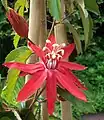| Crimson passion flower | |
|---|---|
 | |
| Scientific classification | |
| Kingdom: | Plantae |
| Clade: | Tracheophytes |
| Clade: | Angiosperms |
| Clade: | Eudicots |
| Clade: | Rosids |
| Order: | Malpighiales |
| Family: | Passifloraceae |
| Genus: | Passiflora |
| Species: | P. vitifolia |
| Binomial name | |
| Passiflora vitifolia | |
Passiflora vitifolia, the perfumed passionflower,[1] is a species of Passiflora, native to southern Central America (Costa Rica, Nicaragua, Panama) and northwestern South America (Venezuela, Colombia, Ecuador, Peru).
Description
It is a vine with cylindric stems covered in red-brown hairs when young. The leaves are serrate, three-lobed, up to 15 cm long and 18 cm broad. The lobed leaves' resemblance to grape leaves gives this passionflower its specific epithet, "vitifolia," meaning "grape leaves" after the Latin for grape "vitis." The flowers are bright red, up to 9 cm diameter. The fruit is a berry 5 cm long and 3 cm broad, with green flesh speckled with white, slight downy hairs, containing numerous seeds.[2][3][4] The fruit is quite sour when it falls off the plant and can take a month to ripen to its full flavor of sour strawberries.[4] Due to the fragrant fruit, it is in small-scale cultivation in the Caribbean.[4]
Image Gallery
 Passiflora vitifolia
Passiflora vitifolia.jpg.webp) Tacsonia sanguinea Sm.
Tacsonia sanguinea Sm. unripe fruit
unripe fruit
References
- ↑ USDA, NRCS (n.d.). "Passiflora vitifolia". The PLANTS Database (plants.usda.gov). Greensboro, North Carolina: National Plant Data Team. Retrieved 15 September 2015.
- ↑ "Passiflora vitifolia". Germplasm Resources Information Network. Agricultural Research Service, United States Department of Agriculture. Retrieved 18 December 2017.
- ↑ Anthony Julian Huxley; Mark Griffiths (1992-04-01). Dictionary of Gardening. ISBN 978-0-333-47494-5.
- 1 2 3 Ulmer, Torsten and John Mochrie MacDougal, eds. (2004). "Passiflora: passionflowers of the world". Timber Press.